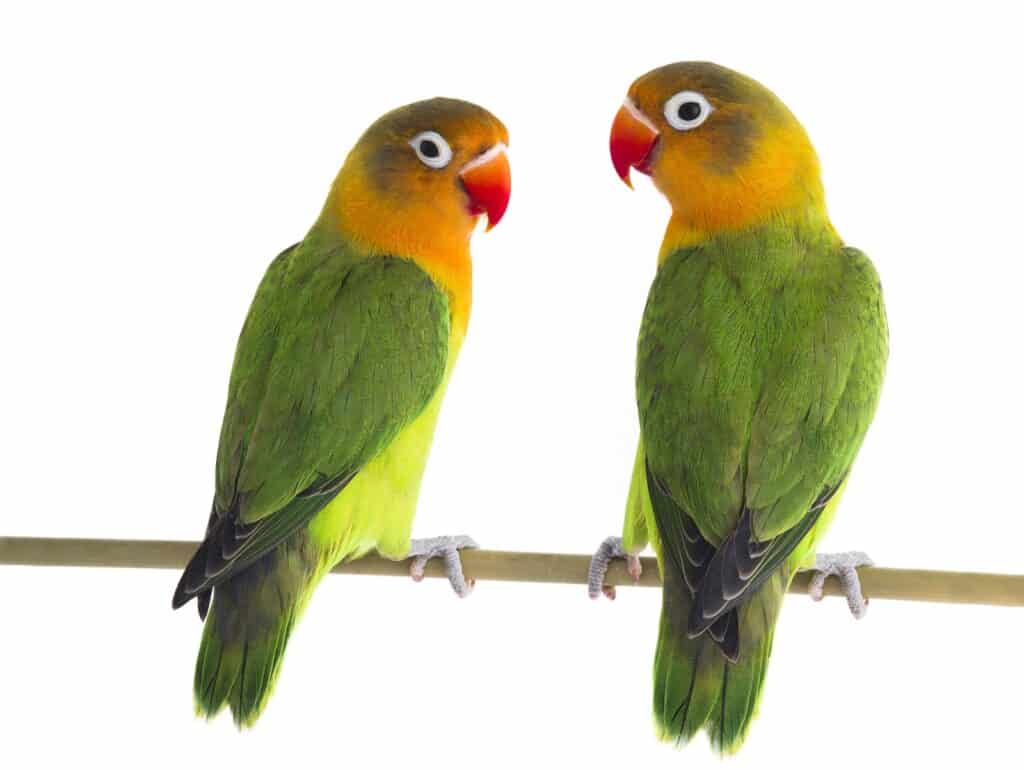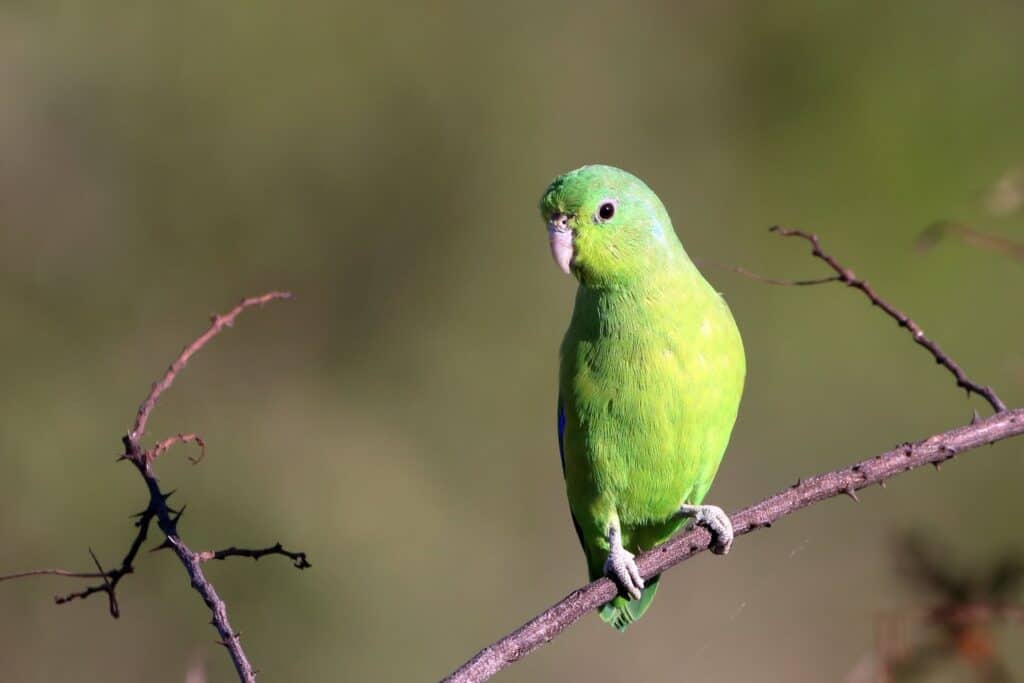Are you planning on introducing a small parrot to your aviary but are stuck between lovebird vs. parrotlet? We’re not surprised; they’re colorful and loving creatures that make exceptional pets. But despite their visual and size similarities, these minute parrots have several differences. So if you want to know the difference between a lovebird and vs. parrotlet, please read on.
Key Takeaways
Lovebird vs. parrotlet: which one makes the best pet? Well, the answer to this question varies with the person. Of the two parrots, the lovebirds are the largest and the noisiest. These creatures have several differences and similarities. Some of the differences include the following:
- Lovebirds are 2 inches longer than parrotlets and weigh even more.
- Parrotlets and lovebirds are aggressive, so training them can be challenging.
- Lovebirds may be noisier, but you can teach them how to talk.
- Parrotlets tend to live longer than lovebirds.
- Despite having a more petite body, parrotlets tend to be more active; therefore, they can consume more food. After all, they do burn more calories than lovebirds.
- Lovebirds need to have a companion, but parrotlets can live alone.
So if you’re looking for a silent and smaller option, you should go for parrotlet. But if you can deal with the noises and have less time to spend with them, you should get a pair of lovebirds. But your likes and preferences will determine the final decision, so do your research.
Lovebird vs. Parrotlet: Introduction to These Parrots
What is a Lovebird?

Other than being popular pets, lovebirds make great pets that live in the wild in small groups. They belong to the genus Agapornis, a group of small-sized parrots belonging to the Old World family of parrots. They are known for being affectionate to each other and their owners; plus, they tend to bite each other’s beaks.
The genus Agapornis, commonly known as lovebirds, includes nine species native to Africa. The gray-headed is indigenous to Madagascar. Despite their popularity, people only keep a few species as pets, the most popular being Fischer’s lovebird.
These affectionate and social minute parrots’ names come from their strong monogamous nature and long bonding periods. They are known for sitting on the perch together for a long time. These birds feed on seeds, grasses, veggies, and fruit.
Pros
- They are easy to maintain.
- They make great pets for first-time owners.
- They can mimic our voices.
- They’re gorgeous.
Cons
- They’re noisy
- They’re known biters, especially when around strangers.
What is a Parrotlet?

“Parrotlets” refers to a group of New World’s smallest parrot species comprising several genera, including Touit, Nannopsittaca, and Forpus. These stocky-built birds come with extremely short tails and are indigenous to South and Middle America.
They resemble the lovebirds from Africa in behavior, size, and body shape. And even though they’re not related to the lovebirds, they’re at times referred to as the South American lovebirds. Their nickname is the reason why they are usually mistaken for lovebirds. Therefore, newbies can easily mistake it for a lovebird.
In the wild, they usually travel in huge flocks whose size ranges between 4 and more than a hundred parrots. On the other hand, some species travel in a flock of between 5 and 40 species. And just like the lovebirds, the parrotlets form tight, lifetime pair bonds with their mates.
Pros
- They make great pets for first-time bird owners.
- They’re active but not noisy, which makes them ideal for buildings with noise-sensitive neighbors.
- You can teach them to speak a few words.
- They respond to their names and can learn a few tricks.
Cons
- They’re high-maintenance parrots
- They require your attention.
Lovebird vs. Parrotlet: Features Face to Face
Physical Appearance
As aforementioned, they are both considered the smallest parrots in the world. Despite their size, they act like giant parrots trapped in small bodies. Compared to all the parrotlet species, the lovebirds are a bit bigger.
Lovebirds are between 13 and 17 cm (5 to 7 inches) long and weigh about 60 grams. They have a blunt, cute tails and stocky build body. Unfortunately, differentiating between male and female lovebirds can be pretty challenging. The wild-type lovebirds are usually greenish with a wide range of colors on their upper bodies.
The masked lovebird, black-cheeked, and Fischer’s lovebirds come with a unique white ring around their eyes. There is a wide range of color mutants that breeders have produced through selective breeding over the last few decades.
On the other hand, the parrotlets are about 5 inches long and weigh about 28 grams. Unlike the lovebirds, the parrotlets are dimorphic, which means that the males and females look different. The males have some blue markings on their wings, tails, and head, whereas the females don’t have these markings. On some females, they’re barely visible.
The wild pacific parrotlet has a pink beak and bright green mask, and their bodies range from gray to green.
In terms of dimorphism, the parrotlets are the winners; after all, you can easily differentiate between males and females. On the other hand, the lovebirds win in terms of body size and weight. But if your goal is getting the smallest parrot, you should go for the parrotlet.
Personality
Lovebirds are territorial creatures that can be pretty aggressive, but the females are more prone to biting than the males. Some pet owners have complained that the female’s bite can be painful. On the other hand, the males aren’t that aggressive; in fact, they can be more accommodating.
Unfortunately, their aggressive nature doesn’t make them the most accessible pets to tame. And the fact that they always prefer to stay with their mates can make them a bit challenging to tame. Therefore, you have to be patient, and with time you will tame it and finally get it tweeting all day long and doing a few tricks on your command.
On the other hand, parrotlets are also aggressive, but that is because of their territorial nature and jealousy. Unlike the lovebirds, they’re not scared of humans and other animals; they have been known to attack when provoked.
These minute creatures are willful, affectionate, and aggressive. And like the lovebirds, if you want to bond with your new parrotlet, you should adopt only one pet. After all, these parrots may end up connecting more and exclude you.
Both lovebirds and parrotlets are aggressive towards other creatures that aren’t their pals, and this includes the human beings they haven’t bonded with. Therefore, they could do better when paired with other bird species at first, but with time they can get used to each other.
In terms of personality, there is no winner since they have similar behaviors, especially around other species and strangers. Fortunately, they love bonding with their mates and can exclude other pets and people around them.
Lovebird vs. Parrotlet: Who Is Noisier?
In terms of noise, many consider lovebirds noisier, which makes sense since they’re bigger than parrotlets in size. Therefore, they have bigger lungs and can produce loud noises. The lovebirds can hit a volume of over 83 decibels, while the parrotlets can hit 65 decibels. The lovebirds are about 30% louder than the parrotlets.
Lovebirds are known for producing ear-piercing noises that can be heard all over the house, especially when excited. Generally, they would chirp and tweet lightly when chatting, and as they get excited, the noises will increase. They can be even louder when talking or playing with their owners.
On the other hand, parrotlet’s noises are a bit tolerable. Still, when excited, you’ll have to move away from the cage or cover it with a blanket. So if you live in an apartment, you should find ways to soundproof your house.
Training
Generally, training parrots are more challenging than training cats and dogs. You shouldn’t expect too much cooperation from the birds as you would from our canine pals. Therefore, you will have to take your time and be patient with the lovebirds and parrotlets.
Remember, the initial bonding process will take up more of your time than you think. So you should prepare for an arduous bonding process, but they are worth it; after all, they can keep you company for over two decades.
But when trained, parrotlets can become great pets. And that is because they can do a few tricks, listen to simple instructions and speak. The males are very easy to train, but it will vary with species as some parrotlets are only sometimes eager to learn.
On the other hand, lovebirds are the same, especially regarding patience. When teaching them new tricks, you should be patient and ensure you have enough time. So in terms of training, we have a draw since they are both hard to train and need patience.
Lifespan
Parrots make long-term companions, but some have shown the ability to live longer than others. So when you adopt these birds, you should know that you will have a partner for two decades. They tend to live longer in captivity than in the wild if well taken off.
The lovebirds have a lifespan of between 15 to 20 years, with some species, like the Rosy-faced lovebird living for over 25 years. Conversely, parrotlets have been known to live for between 20 and 30 years.
In terms of lifespan, the parrotlets win as they can live for over three decades when well-taken care of. But when well-taken care of, some lovebird species can live even longer.
Speaking Abilities
If you’re looking for a parrot that can talk, then you should stay from these two choices. After all, they’re not the best talkers, but you can still teach them to speak a few words. Unfortunately, you’ll have more success with the males than the females. Male parrotlets tend to learn faster than females. Besides singing and mimicking sounds, the males can quickly learn several words.
Lovebirds are not great learners, especially when it comes to talking. They can copy your sounds, but they rarely speak to themselves. Parrotlets don’t cry and produce chirping noises while the lovebirds chatter; therefore, there is no winner between lovebirds vs. parrotlet.
Feeding
Parrotlets are more active than lovebirds; therefore, they need to feed more since they burn more calories. They are even known to consume more food than huge cockatiels. Fortunately, these birds feed on the same types of seeds. So, if you adopt a parrotlet, then you should be ready to spend more on food than with a lovebird.
In terms of food consumption, parrotlets are the winner. Despite being smaller than lovebirds, they do consume more food. So if you plan on saving some cash on food, you should go for the lovebirds.
Stand Out Features
Bathing
All parrots, despite their body size, have to be bathed regularly. After all, they lose feathers and develop a buildup of dead skin cells, dirt, and dust. Therefore, you need to wash them a couple of times per week.
These small parrots should get a bath at least twice weekly, so you can wash your pet using a spray bottle. On the other hand, lovebirds need more bathing than parrotlets. So you should install some shallow bowls and showers for them; playing with water is one of their favorite activities. If you don’t have shower bowls, you can also bathe them using a spray bottle.
Pairing
Unlike parrotlets, lovebirds do well as a pair; they tend to bond better with their mates. After all, they’re monogamous creatures that mate for life. Their parrots have been known to leave other birds and owners alone just to focus on themselves.
So when investing in a pair of lovebirds, you should account for the pair, not just a single bird. On the other hand, pairing is optional for parrotlets. They may be monogamous, but they’re still known for living alone or with other parrots for years.
Activity
Generally, they’re active, curious, and acrobatic. These birds love toys; when with their owners, they hang out on their owners’ shoulders. They have been known to even hide under a person’s hair or in a pocket. Hiding under your hair or in your pockets is a form of affection.
They love swings, so when you’re not at home, you can keep both of them entertained with their toys. Their toys can help keep them busy all day long, but most importantly, they need a workout gym. The workout gym can help your pet burn extra calories.
Different Species Make Great Pets
There are nine species of lovebirds; unfortunately, they don’t all make great pets; some are even hard to tame. But the most popular options that are kept as pets include Fischer’s, masked, and peach-faced lovebirds.
On the other hand, the parrotlets are split into three genera with 19 species. Unfortunately, most of these birds don’t make great pets. The most popular species that make great pets include spectacle, green-rumped and pacific parrotlets. So you must get to know more about a species before adopting one.
For instance, the perch-faced lovebird comes in several rainbow color mutations and can make a great pet. These pets can be tamed as chicks and remain loyal for the rest of their lives. However, there have been instances of a few species not remaining tamed when adults after being tamed while young.
Parrotlet lovers prefer keeping pacific parrotlets because of the many available color mutations. They are also stubborn and feisty but loving, so you should be patient with them.
Many bird enthusiasts love the spectacled birds for their color mutations. They’re also bold, and both sexes can learn to speak. On the other hand, Green-rumped parrots are very shy, but they can still make great pets.
Nesting Behaviors
Some lovebirds have a unique nesting behavior; for instance, the peach-faced lovebirds tend to shred everything and stick them in their feathers. They can even stick palm fronds or pieces of paper in their rump feathers and start walking or flying around decorated. This nesting behavior is unique and unfamiliar to other parrotlets and lovebird species.
Are Lovebirds Louder Than Parrotlets?
Parrots are noisy creatures that love playing with each other and their owners. Unfortunately, the larger parrots tend to be louder than their smaller counterparts. This rule also applies to parrotlets and lovebirds. Lovebirds are more significant, so they tend to be louder than parrotlets. The lovebird produces a shrill clock call and can spend most of their day making noises.
On the other hand, parrotlets are less noisy; sure, they do vocalize quite often, but their noises are bearable. So if you lived in a small apartment and were wondering between lovebird vs. parrotlet is the best, then you should go for parrotlets. They make great companions for folks living in small apartments.
- Wikipedia contributors, parrotlet, https://en.wikipedia.org/wiki/Parrotlet/ accessed January 4, 2023.
- Wikipedia contributors, lovebird, https://en.wikipedia.org/wiki/Lovebird/ accessed January 4, 2023.
- Nicholas Sfectu, The Bords World, https://books.google.co.ke/books?id=irOaBQAAQBAJ&pg=PA893&dq=lovebirds+size&hl=en&sa=X&ved=2ahUKEwja5auEpa_8AhXAZaQEHX9nBCAQ6AF6BAgCEAI#v=onepage&q=lovebirds%20size&f=false/ accessed January 4, 2023.
- Wikipedia contributors, Rosy-faced lovebird, https://en.wikipedia.org/wiki/Rosy-faced_lovebird/ accessed January 4, 2023.
- Wikipedia contributors, Spectacled parrot, https://en.wikipedia.org/wiki/Spectacled_parrotlet#Description/ accessed January 4, 2023.
- Edward Price, Behavior Genetics, https://books.google.co.ke/books?id=08gXl-amuHEC&pg=PA18&dq=peach-faced+lovebird+nesting+behavior&hl=en&sa=X&ved=2ahUKEwjV3eX4gbD8AhUbTaQEHdzPCzMQ6AF6BAgFEAI#v=onepage&q=peach-faced%20lovebird%20nesting%20behavior&f=false/ accessed January 4, 2023.
- Wikipedia contributors, Pacific Parrotlet, https://en.wikipedia.org/wiki/Pacific_parrotlet/ accessed January 4, 2023.




